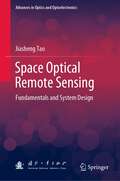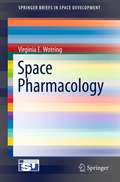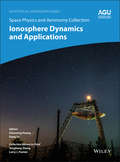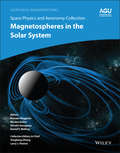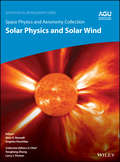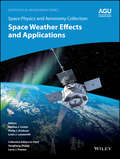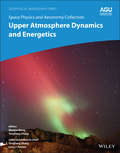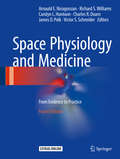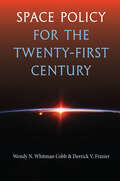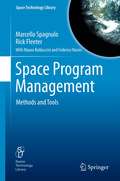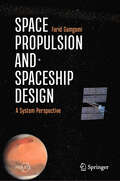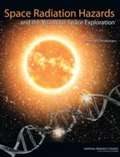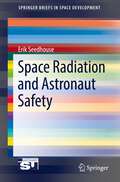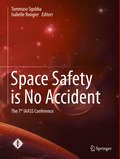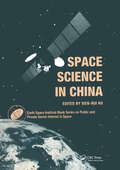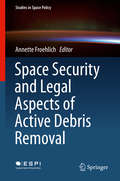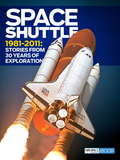- Table View
- List View
Space Optical Remote Sensing: Fundamentals and System Design (Advances in Optics and Optoelectronics)
by Jiasheng TaoThis book highlights the fundamentals, technologies, and methods of space optical remote sensing and system design. The author introduces concepts and methods established during his decades of research and practice, covering topics such as difference between the spatial resolution of pixel and the resolution of traditional film, the resolution of remote sensing image for characteristics and target recognition purpose, and image shift problem of sampling image space. The book comprehensively and systematically introduces the basic concepts, theories, parameter design calculations of imaging cameras, multispectral cameras, surveying cameras, infrared cameras, and imaging spectrometers, their respective system components, and performance evaluation of space optical remote sensing systems. The book also discusses the overall design of space optical remote sensing systems, including light sources, the ground-air system, target characteristics, spectrum selection, energy calculation, orbital parameters, optical remote sensor parameters, spacecraft parameters coordination and selection, comprehensive analysis, and large-scale system performance evaluation methods, forming a complete idea on how to achieve the goals of the system design. The book enables readers to understand the working principles of the whole systems from a theoretical depth and grasp the full skillset on how to implement advantages and balance technical difficulties for orbit, subsystems of the platform, and payloads. The book is a must-read for those who seek to build strong ability for research, development, and innovation surrounding the subject matter.
Space Pharmacology
by Virginia E. Wotring"Space Pharmacology" is a review of the current knowledge regarding the use of pharmaceuticals during spaceflights. It is a comprehensive review of the literature, addressing each area of pharmacokinetics and each major physiological system in turn. Every section begins with a topic overview, and is followed by a discussion of published data from spaceflight, and from ground experiments meant to model the spaceflight situation. Includes a discussion looking forward to the new medical challenges we are likely to face on longer duration exploration missions. This book is a snapshot of our current knowledge that also highlights areas of unknown.
Space Physics
by Christopher T. Russell Russell, Christopher T. and Luhmann, Janet G. and Strangeway, Robert J. Janet G. Luhmann Robert J. StrangewayAll aspects of space plasmas in the Solar System are introduced and explored in this text for senior undergraduate and graduate students. Introduction to Space Physics provides a broad, yet selective, treatment of the complex interactions of the ionized gases of the solar terrestrial environment. The book includes extensive discussion of the Sun and solar wind, the magnetized and unmagnetized planets, and the fundamental processes of space plasmas including shocks, plasma waves, ULF waves, wave particle interactions, and auroral processes. The text devotes particular attention to space plasma observations and integrates these with phenomenological and theoretical interpretations. Highly coordinated chapters, written by experts in their fields, combine to provide a comprehensive introduction to space physics. Based on an advanced undergraduate and graduate course presented in the Department of Earth and Space Sciences at the University of California, Los Angeles, the text will be valuable to both students and professionals in the field.
Space Physics and Aeronomy, Ionosphere Dynamics and Applications (Geophysical Monograph Series #260)
by Yongliang Zhang Larry J. PaxtonA comprehensive review of global ionospheric research from the polar caps to equatorial regions9; It's more than a century since scientists first identified the ionosphere, the layer of the Earth's upper atmosphere that is ionized by solar and cosmic radiation. Our understanding of this dynamic part of the near-Earth space environment has greatly advanced in recent years thanks to new observational technologies, improved numerical models, and powerful computing capabilities.9; Ionosphere Dynamics and Applications provides a comprehensive overview of historic developments, recent advances, and future directions in ionospheric research. Volume highlights include:9; Behavior of the ionosphere in different regions from the poles to the equator Distinct characteristics of the high-, mid-, and low-latitude ionosphere Observational results from ground- and space-based instruments Ionospheric impacts on radio signals and satellite operations How earthquakes and tsunamis on Earth cause disturbances in the ionosphere The American Geophysical Union promotes discovery in Earth and space science for the benefit of humanity. Its publications disseminate scientific knowledge and provide resources for researchers, students, and professionals.
Space Physics and Aeronomy, Magnetospheres in the Solar System (Geophysical Monograph Series #259)
by Yongliang Zhang Larry J. PaxtonAn overview of current knowledge and future research directions in magnetospheric physics In the six decades since the term 'magnetosphere' was first introduced, much has been theorized and discovered about the magnetized space surrounding each of the bodies in our solar system. Each magnetosphere is unique yet behaves according to universal physical processes. Magnetospheres in the Solar System brings together contributions from experimentalists, theoreticians, and numerical modelers to present an overview of diverse magnetospheres, from the mini-magnetospheres of Mercury to the giant planetary magnetospheres of Jupiter and Saturn. Volume highlights include: Concise history of magnetospheres, basic principles, and equations Overview of the fundamental processes that govern magnetospheric physics Tools and techniques used to investigate magnetospheric processes Special focus on Earth’s magnetosphere and its dynamics Coverage of planetary magnetic fields and magnetospheres throughout the solar system Identification of future research directions in magnetospheric physics The American Geophysical Union promotes discovery in Earth and space science for the benefit of humanity. Its publications disseminate scientific knowledge and provide resources for researchers, students, and professionals.
Space Physics and Aeronomy, Solar Physics and Solar Wind (Geophysical Monograph Series #258)
by Yongliang Zhang Larry J. PaxtonA comprehensive view of our Sun at the start of a new era in solar and heliospheric physics Humans have been observing and studying our Sun for centuries, yet much is still unknown about the processes that drive its behavior. Thanks to a new generation of space missions and ground telescopes, we are poised to dramatically increase our understanding of the Sun and its environment. Solar Physics and Solar Wind explores advances in solar and heliospheric research over recent decades, as well as the challenges that remain. This comprehensive reference work covers the solar interior, magnetism and radiation, plasma heating and acceleration, the sun's atmosphere, and solar activity. Volume highlights include: Explanations for processes in the solar interior New insights on the solar wind The challenges of measuring the Sun's magnetic field and its radiative output Description of solar atmospheric phenomena such as spicules and jets New developments in understanding flares and coronal mass ejections Ongoing research into how the solar corona is heated The American Geophysical Union promotes discovery in Earth and space science for the benefit of humanity. Its publications disseminate scientific knowledge and provide resources for researchers, students, and professionals.
Space Physics and Aeronomy, Space Weather Effects and Applications (Geophysical Monograph Series #262)
by Yongliang Zhang Larry J. PaxtonExamines how solar and terrestrial space phenomena affect sophisticated technological systems Contemporary society relies on sophisticated technologies to manage electricity distribution, communication networks, transportation safety, and myriad other systems. The successful design and operation of both ground-based and space-based systems must consider solar and terrestrial space phenomena and processes. Space Weather Effects and Applications describes the effects of space weather on various present-day technologies and explores how improved instrumentation to measure Earth's space environment can be used to more accurately forecast changes and disruptions. Volume highlights include: Damage and disruption to orbiting satellite equipment by solar particles and cosmic rays Effects of space radiation on aircraft at high altitudes and latitudes Response of radio and radar-based systems to solar bursts Disturbances to the propagation of radio waves caused by space weather How geomagnetic field changes impact ground-based systems such as pipelines Impacts of human exposure to the space radiation environment The American Geophysical Union promotes discovery in Earth and space science for the benefit of humanity. Its publications disseminate scientific knowledge and provide resources for researchers, students, and professionals.
Space Physics and Aeronomy, Upper Atmosphere Dynamics and Energetics (Geophysical Monograph Series #261)
by Yongliang Zhang Larry J. PaxtonA comprehensive overview of the structure and variability of the upper atmosphere Earth's upper atmosphere is an open system that is strongly influenced by energy and momentum inputs from both above and below. New observation and modeing techniques have provided insights into dynamics, energetics, and chemical processes in the upper atmosphere. Upper Atmosphere Dynamics and Energetics presents an overview of key research advances in upper atmospheric physics, and measurement and modeling techniques, along with remaining challenges for understanding the state and variability of the upper atmospheric system. Volume highlights include: Insights into the interconnections between different areas of upper atmospheric science Appreciation of the dynamics and complexity of the global upper atmospheric system Techniques for observing and measuring the upper atmosphere Responses of the upper atmosphere to external drivers The American Geophysical Union promotes discovery in Earth and space science for the benefit of humanity. Its publications disseminate scientific knowledge and provide resources for researchers, students, and professionals.
Space Physiology and Medicine
by Arnauld E. Nicogossian Richard S. Williams Carolyn L. Huntoon Charles R. Doarn James D. Polk Victor S. SchneiderAs space medicine evolved from the late 1950s onward, the need arose for a ready reference for students and practitioners on the basic concepts of this new specialty. Through three editions edited by leaders in the development of space medicine, this classic text has met the need. This fourth edition of Space Physiology and Medicine provides succinct, evidence-based summaries of the current knowledge base in space medicine and serves as a source of information on the space environment, responses, and practices. Additionally, there is extensive online material available for each chapter, featuring overviews and self-study questions.
Space Policy for the Twenty-First Century
by Wendy N. Whitman Cobb Derrick V. FrazierA foundational, accessible overview of space policy in the United States This book provides readers with the first comprehensive overview of major space policies in the United States and a framework through which to analyze them. It examines all facets of space policy—civilian, military, and commercial—and presents this material accessibly for use by readers at multiple levels, from undergraduate courses to government practitioners making and implementing policy. The first section offers a history of space exploration, focusing on the US within a global context. The second section looks at the actors and institutions involved in setting space policy in a government based on the separation of powers, including the president, Congress, NASA, and the Department of Defense. The book concludes with chapters on the different sectors of space policy, as well as questions this field will face in the future. As policymakers and business leaders become increasingly aware of the everyday systems that depend on space technologies, such as communications, mapping, and weather monitoring, and as space becomes a more visible arena for commercial competition, potential humanitarian gain, and military threats, Space Policy for the Twenty-First Century helps students and professionals navigate the complexity of space as a policy area.
Space Program Management
by Marcello Spagnulo Federico Nasini Mauro Balduccini Rick FleeterBeginning with the basic elements that differentiate space programs from other management challenges, Space Program Management explains through theory and example of real programs from around the world, the philosophical and technical tools needed to successfully manage large, technically complex space programs both in the government and commercial environment. Chapters address both systems and configuration management, the management of risk, estimation, measurement and control of both funding and the program schedule, and the structure of the aerospace industry worldwide.
Space Propulsion and Spaceship Design: A System Perspective (Springer Praxis Books)
by Farid GamgamiThe objective of this textbook is to provide a synopsis of propulsion technologies in the context of spaceship design. The author identified a lack of multidisciplinary textbooks that explain to students both the technology and physics of space propulsion as well as its relationship to other disciplines in the process of spaceship design. To make the subject more tangible, the propulsion demanding context of space exploration was chosen. The book therefore begins with the astronomical context relevant to human exploration of the solar system. This challenging endeavour requires powerful space propulsion systems of various types. Existing and emerging technologies are systematically discussed. Principle similarities and technological analogies between the different types are highlighted. Starting from the physical working principle, the book progressively extends the view to subsystem and system design aspects. This approach recognises that the propulsion subsystem is the most defining architectural element of large spacecraft, i.e. starships. Such a comprehensive presentation of propulsion technology from a system perspective is not yet reflected in the existing literature. In order to apply the fundamental knowledge provided in the first 9 chapters, a mission to the dwarf planet Ceres is presented, where different propulsion technologies have to be combined to achieve the mission objectives. In this way, the reader is introduced to the basics of requirements breakdown, design space analysis and the technical trade-off process, all of which are essential for early mission planning. The book is aimed at advanced undergraduate and graduate students, recent postgraduates, and newcomers to the field of spacecraft design where propulsion is essential.
Space Radiation Hazards and the Vision for Space Exploration: Report of a Workshop
by National Research Council of the National AcademiesFulfilling the President’s Vision for Space Exploration (VSE) will require overcoming many challenges. Among these are the hazards of space radiation to crews traveling to the Moon and Mars. To explore these challenges in some depth and to examine ways to marshal research efforts to address them, NASA, NSF, and the NRC sponsored a workshop bringing together members of the space and planetary science, radiation physics, operations, and exploration engineering communities. The goals of the workshop were to increase understanding of the solar and space physics in the environment of Earth, the Moon, and Mars; to identify compelling relevant research goals; and discuss directions this research should take over the coming decade. This workshop report presents a discussion of radiation risks for the VSE, an assessment of specifying and predicting the space radiation environment, an analysis of operational strategies for space weather support, and a summary and conclusions of the workshop.
Space Radiation and Astronaut Safety (Springerbriefs In Space Development Ser.)
by Erik SeedhouseThis brief explores the biological effects of long-term radiation on astronauts in deep space. As missions progress beyond Earth's orbit and away from the protection of its magnetic shielding, astronauts risk constant exposure to higher levels of galactic cosmic rays and solar particle events. The text concisely addresses the full spectrum of biomedical consequences from exposure to space radiation and goes on to present possible ways to mitigate such dangers and protect astronauts within the limitations of existing technologies.
Space Safety is No Accident
by Tommaso Sgobba Isabelle RongierIncludes the proceedings from the 7th IAASS Conference, "Space Safety is No Accident," held in Friedrichshafen, Germany, in October 2014. The 7th IAASS Conference, "Space Safety is No Accident" is an invitation to reflect and exchange information on a number of topics in space safety and sustainability of national and international interest. The conference is also a forum to promote mutual understanding, trust and the widest possible international cooperation in such matters. The once exclusive "club" of nations with autonomous sub-orbital and orbital space access capabilities is becoming crowded with fresh and ambitious new entrants. New commercial spaceports are starting operations and others are being built. In the manned spaceflight arena a commercial market is becoming a tangible reality with suborbital spaceflights and government use of commercial services for cargo and crew transportation to orbit. Besides the national ambitions in space, the international cooperation both civil and commercial is also gaining momentum. In the meantime robotic space exploration will accelerate and with it the need to internationally better regulate the usage of nuclear power sources. Space-bound systems and aviation traffic will share more and more a crowded airspace, while aviation will increasingly rely on space-based safety-critical services. Finally, most nations own nowadays space assets, mainly satellites of various kinds and purposes, which are under the constant threat of collision with other spacecraft and with the ever increasing number of space debris. Awareness is increasing internationally (as solemnly declared since decades in space treaties) that space is a mankind asset and that we all have the duty of caring for it. Without proactive and courageous international initiatives to organize space, we risk to negate access and use of space to future generations.
Space Science in China (Earth Space Institute Book Ser. #Vol. 1)
by Wen-Rui HuSpace science in China is one of the most active areas in modern science, and China has played a dynamic and steadily increasing role in this field since the 1960s. Until recently, however, activity in China was a mystery to the rest of the world. With the commercial importance of space, and the fact that space is now used as a laboratory to carry out various experiments, China has recently emerged as an important international competitor. Space Science in China provides a clear understanding of the latest research and progress in such wide-ranging areas as the development and research in solar-terrestrial science, space astronomy, geoscience, remote sensing, microgravity science, and life science.
Space Science, Module H (HMH Science Dimensions™)
by Marjorie Frank Michael R. Heithaus Michael A. DiSpezioNIMAC-sourced textbook
Space Security and Legal Aspects of Active Debris Removal (Studies in Space Policy #16)
by Annette FroehlichThe book analyzes the various legal and political concepts to resolve the problem of the existing space debris in outer space and which measures have been taken to avoid space debris or to reduce potential space debris in the course of future space missions. From a scientific and technical point of view various studies are ongoing to analyze the feasibility of active debris removal. Nevertheless it has to be highlighted that outer space is an international area where various actors with different legal and political concepts are operating, a situation that leads to different approaches concerning such activities.
Space Shuttle 1981-2011
by Sally Ride T. A. Heppenheimer Air Space Magazine Greg FreiherrSpace Shuttle 1981-2011 is a lavishly illustrated special edition celebrating the space shuttle era. In thirty years of operation, space shuttles were used in 135 different missions; this volume presents the adventure stories of many of these missions in the astronauts' own words. Additional contributions by space exploration writers cover the history of the program, technological challenges and triumphs, scientific achievements, and the devastating Challenger and Columbia tragedies. Complete with more than 40 essays and 100 full-color photographs, Space Shuttle 1981-2011 is a captivating overview of this critical part of space history. Although the space shuttle era has ended, its spirit--that of limitless curiosity and a desire for perfection--continues to inspire.
Space Studies Board Annual Report 2013
by Space Studies BoardThe original charter of the Space Science Board was established in June 1958, 3 months before the National Aeronautics and Space Administration (NASA) opened its doors. The Space Science Board and its successor, the Space Studies Board (SSB), have provided expert external and independent scientific and programmatic advice to NASA on a continuous basis from NASA's inception until the present. The SSB has also provided such advice to other executive branch agencies, including the National Oceanic and Atmospheric Administration (NOAA), the National Science Foundation (NSF), the U.S. Geological Survey (USGS), the Department of Defense, as well as to Congress. Space Studies Board Annual Report 2013 covers a message from the chair of the SSB, Charles F. Kennel. This report also explains the origins of the Space Science Board, how the Space Studies Board functions today, the SSB's collaboration with other National Research Council units, assures the quality of the SSB reports, acknowledges the audience and sponsors, and expresses the necessity to enhance the outreach and improve dissemination of SSB reports. This report will be relevant to a full range of government audiences in civilian space research - including NASA, NSF, NOAA, USGS, and the Department of Energy, as well members of the SSB, policy makers, and researchers.
Space Studies Board Annual Report 2013
by Space Studies BoardThe original charter of the Space Science Board was established in June 1958, 3 months before the National Aeronautics and Space Administration (NASA) opened its doors. The Space Science Board and its successor, the Space Studies Board (SSB), have provided expert external and independent scientific and programmatic advice to NASA on a continuous basis from NASA's inception until the present. The SSB has also provided such advice to other executive branch agencies, including the National Oceanic and Atmospheric Administration (NOAA), the National Science Foundation (NSF), the U.S. Geological Survey (USGS), the Department of Defense, as well as to Congress. Space Studies Board Annual Report 2013 covers a message from the chair of the SSB, Charles F. Kennel. This report also explains the origins of the Space Science Board, how the Space Studies Board functions today, the SSB's collaboration with other National Research Council units, assures the quality of the SSB reports, acknowledges the audience and sponsors, and expresses the necessity to enhance the outreach and improve dissemination of SSB reports. This report will be relevant to a full range of government audiences in civilian space research - including NASA, NSF, NOAA, USGS, and the Department of Energy, as well members of the SSB, policy makers, and researchers.
Space Studies Board Annual Report 2013
by Space Studies BoardThe original charter of the Space Science Board was established in June 1958, 3 months before the National Aeronautics and Space Administration (NASA) opened its doors. The Space Science Board and its successor, the Space Studies Board (SSB), have provided expert external and independent scientific and programmatic advice to NASA on a continuous basis from NASA's inception until the present. The SSB has also provided such advice to other executive branch agencies, including the National Oceanic and Atmospheric Administration (NOAA), the National Science Foundation (NSF), the U.S. Geological Survey (USGS), the Department of Defense, as well as to Congress. Space Studies Board Annual Report 2013 covers a message from the chair of the SSB, Charles F. Kennel. This report also explains the origins of the Space Science Board, how the Space Studies Board functions today, the SSB's collaboration with other National Research Council units, assures the quality of the SSB reports, acknowledges the audience and sponsors, and expresses the necessity to enhance the outreach and improve dissemination of SSB reports. This report will be relevant to a full range of government audiences in civilian space research - including NASA, NSF, NOAA, USGS, and the Department of Energy, as well members of the SSB, policy makers, and researchers.
Space Studies Board: Annual Report 2009
by National Research Council of the National AcademiesThe Space Studies Board (SSB) was established in 1958 to serve as the focus of the interests and responsibilities in space research for the National Academies. The SSB provides an independent, authoritative forum for information and advice on all aspects of space science and applications, and it serves as the focal point within the National Academies for activities on space research. It oversees advisory studies and program assessments, facilitates international research coordination, and promotes communications on space science and science policy between the research community, the federal government, and the interested public. The SSB also serves as the U.S. National Committee for the International Council for Science Committee on Space Research (COSPAR). The present volume reviews the organization, activities, and reports of the SSB for the year 2009.
Space Studies Board: Annual Report 2014
by National Research Council of the National AcademiesUnder the leadership of Jonathan Lunine and Mitch Daniels, the Committee on Human Spaceflight completed one of the most challenging studies undertaken by the Space Studies Board and the Aeronautics and Space Engineering Board. In Pathways to Exploration: Rationales and Approaches for a U.S. Program of Human Exploration, a diverse committee of experts tackled not only the question, How should humans explore space?, but the even more challenging question, Why should humans explore space? <P> The committee identified a pair of enduring questions that motivate human spaceflight: How far from Earth can humans go? and What can humans discover and achieve when we get there? The committee then explored a range of rationales for human spaceflight ranging from the pragmatic (its economic, national security, scientific exploration, international relations, and technology impacts) to the aspirational—the notion that space is humanity’s future. While the committee did not identify a single rationale as the primary justification for space exploration and could not quantify the economic benefit of space exploration, it did conclude that a mix of rationales motivates space exploration. <P><P> Along with an examination of public and stakeholder attitudes about human exploration, the report evaluated three different pathways to illustrate the trade-offs among affordability, schedule, developmental risk, and the frequency of missions for different sequences of intermediate destinations. The pathways, all of which culminate in landing on the surface of Mars, include some combination of missions to asteroids, the Moon, and martian moons.
